International Student Course and University Preferences in Australia
VerifiedAdded on 2020/04/01
|15
|4127
|303
Project
AI Summary
This project analyzes the preferences of international students regarding Australian universities and courses. It explores the significant growth in international higher education and the increasing flow of students across borders. The research investigates the factors influencing international students' decisions when selecting universities and courses in Australia. The project aims to identify the key motivations and considerations, including university characteristics, host country attributes, information sources, benefits, and risks. The methodology involves quantitative research, including questionnaires and data analysis, focusing on students in Melbourne. The study addresses a research gap by specifically examining the factors influencing international student choices in Australia, contributing to the existing literature and offering insights for universities and governments to attract more international students. The project includes a literature review, research questions, and hypotheses to guide the analysis, with limitations acknowledged in terms of scope and sample size. The findings are expected to provide valuable recommendations for Australian universities to enhance their appeal to international students.
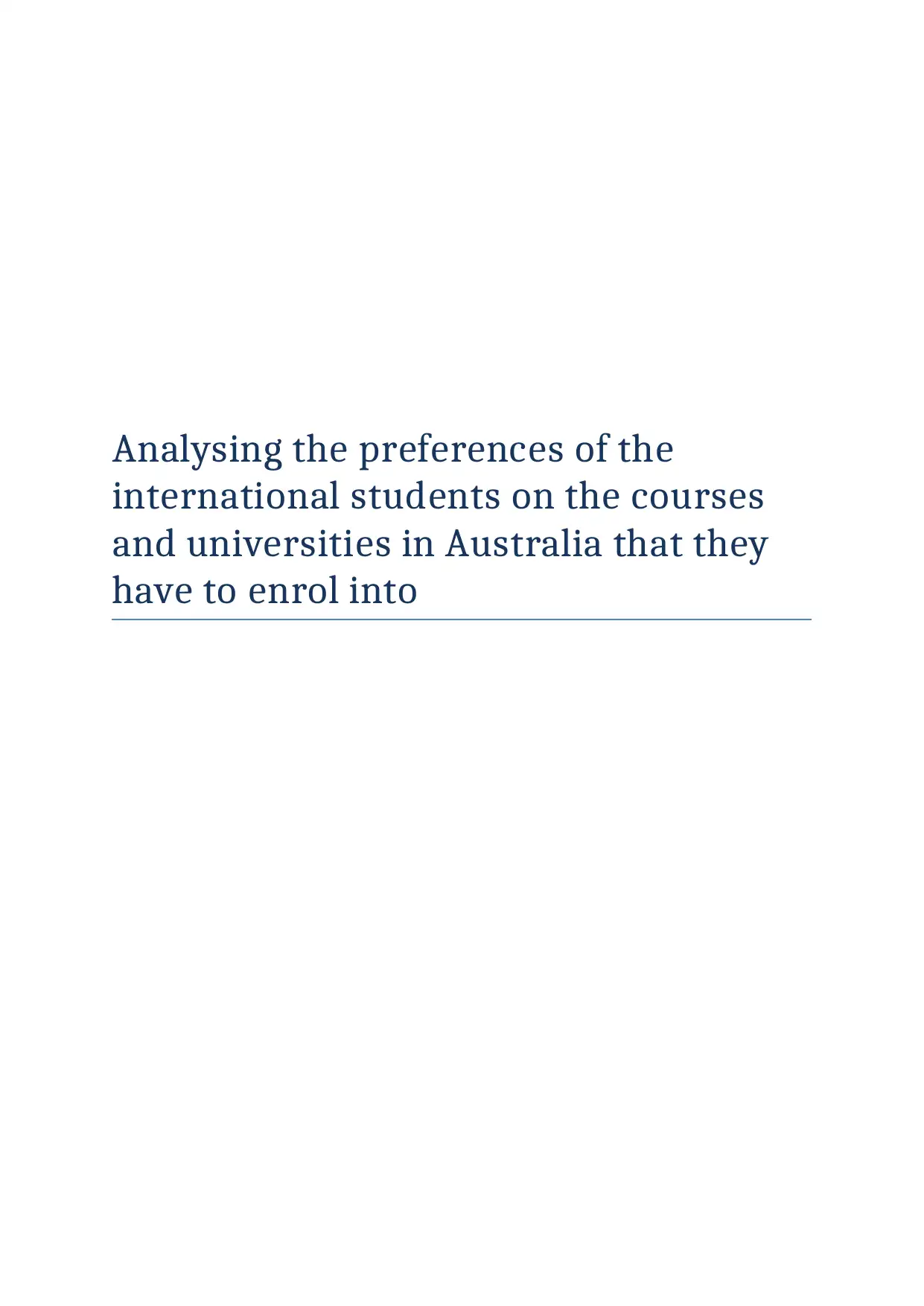
Analysing the preferences of the
international students on the courses
and universities in Australia that they
have to enrol into
international students on the courses
and universities in Australia that they
have to enrol into
Paraphrase This Document
Need a fresh take? Get an instant paraphrase of this document with our AI Paraphraser

Table of Contents
1. Introduction.......................................................................................................................................2
2. Project Objectives..............................................................................................................................2
3. Project Scope.....................................................................................................................................3
4. Literature Review..............................................................................................................................4
Problem Statement.............................................................................................................................5
Research Gap.....................................................................................................................................6
Hypothesis.........................................................................................................................................6
5. Research Questions...........................................................................................................................7
Primary Question...............................................................................................................................7
Secondary Questions.........................................................................................................................7
6. Research Design and Methodology...................................................................................................7
Quantitative Research........................................................................................................................7
Research Instrument..........................................................................................................................8
Quantitative Data Analysis Process...................................................................................................8
Sampling and Sample Size................................................................................................................9
Questionnaire Design........................................................................................................................9
Reliability and Validity of Data.........................................................................................................9
7. Research Limitations.......................................................................................................................10
8. Time Schedule.................................................................................................................................10
9. Conclusion.......................................................................................................................................11
Reference List......................................................................................................................................12
1 | P a g e
1. Introduction.......................................................................................................................................2
2. Project Objectives..............................................................................................................................2
3. Project Scope.....................................................................................................................................3
4. Literature Review..............................................................................................................................4
Problem Statement.............................................................................................................................5
Research Gap.....................................................................................................................................6
Hypothesis.........................................................................................................................................6
5. Research Questions...........................................................................................................................7
Primary Question...............................................................................................................................7
Secondary Questions.........................................................................................................................7
6. Research Design and Methodology...................................................................................................7
Quantitative Research........................................................................................................................7
Research Instrument..........................................................................................................................8
Quantitative Data Analysis Process...................................................................................................8
Sampling and Sample Size................................................................................................................9
Questionnaire Design........................................................................................................................9
Reliability and Validity of Data.........................................................................................................9
7. Research Limitations.......................................................................................................................10
8. Time Schedule.................................................................................................................................10
9. Conclusion.......................................................................................................................................11
Reference List......................................................................................................................................12
1 | P a g e
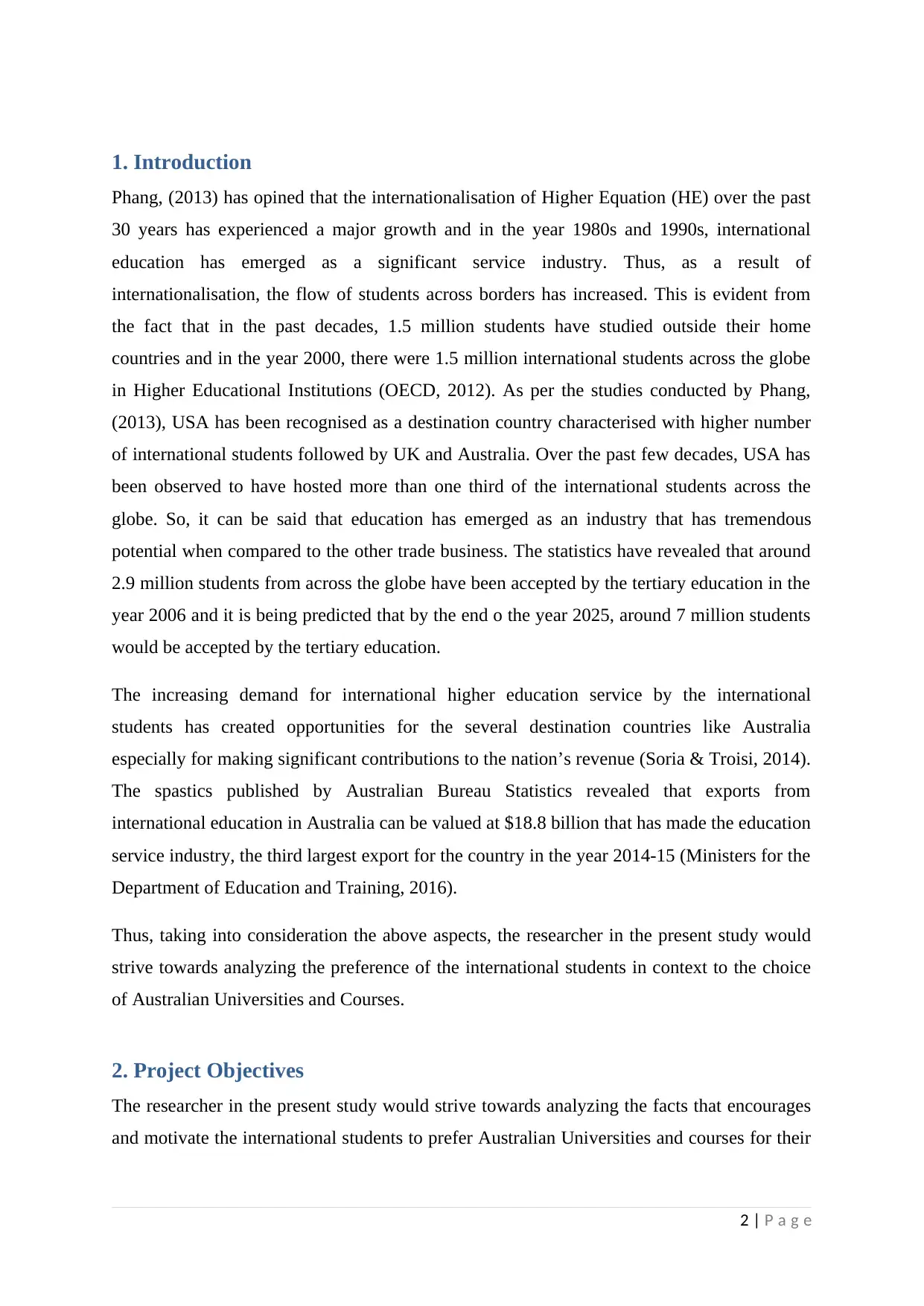
1. Introduction
Phang, (2013) has opined that the internationalisation of Higher Equation (HE) over the past
30 years has experienced a major growth and in the year 1980s and 1990s, international
education has emerged as a significant service industry. Thus, as a result of
internationalisation, the flow of students across borders has increased. This is evident from
the fact that in the past decades, 1.5 million students have studied outside their home
countries and in the year 2000, there were 1.5 million international students across the globe
in Higher Educational Institutions (OECD, 2012). As per the studies conducted by Phang,
(2013), USA has been recognised as a destination country characterised with higher number
of international students followed by UK and Australia. Over the past few decades, USA has
been observed to have hosted more than one third of the international students across the
globe. So, it can be said that education has emerged as an industry that has tremendous
potential when compared to the other trade business. The statistics have revealed that around
2.9 million students from across the globe have been accepted by the tertiary education in the
year 2006 and it is being predicted that by the end o the year 2025, around 7 million students
would be accepted by the tertiary education.
The increasing demand for international higher education service by the international
students has created opportunities for the several destination countries like Australia
especially for making significant contributions to the nation’s revenue (Soria & Troisi, 2014).
The spastics published by Australian Bureau Statistics revealed that exports from
international education in Australia can be valued at $18.8 billion that has made the education
service industry, the third largest export for the country in the year 2014-15 (Ministers for the
Department of Education and Training, 2016).
Thus, taking into consideration the above aspects, the researcher in the present study would
strive towards analyzing the preference of the international students in context to the choice
of Australian Universities and Courses.
2. Project Objectives
The researcher in the present study would strive towards analyzing the facts that encourages
and motivate the international students to prefer Australian Universities and courses for their
2 | P a g e
Phang, (2013) has opined that the internationalisation of Higher Equation (HE) over the past
30 years has experienced a major growth and in the year 1980s and 1990s, international
education has emerged as a significant service industry. Thus, as a result of
internationalisation, the flow of students across borders has increased. This is evident from
the fact that in the past decades, 1.5 million students have studied outside their home
countries and in the year 2000, there were 1.5 million international students across the globe
in Higher Educational Institutions (OECD, 2012). As per the studies conducted by Phang,
(2013), USA has been recognised as a destination country characterised with higher number
of international students followed by UK and Australia. Over the past few decades, USA has
been observed to have hosted more than one third of the international students across the
globe. So, it can be said that education has emerged as an industry that has tremendous
potential when compared to the other trade business. The statistics have revealed that around
2.9 million students from across the globe have been accepted by the tertiary education in the
year 2006 and it is being predicted that by the end o the year 2025, around 7 million students
would be accepted by the tertiary education.
The increasing demand for international higher education service by the international
students has created opportunities for the several destination countries like Australia
especially for making significant contributions to the nation’s revenue (Soria & Troisi, 2014).
The spastics published by Australian Bureau Statistics revealed that exports from
international education in Australia can be valued at $18.8 billion that has made the education
service industry, the third largest export for the country in the year 2014-15 (Ministers for the
Department of Education and Training, 2016).
Thus, taking into consideration the above aspects, the researcher in the present study would
strive towards analyzing the preference of the international students in context to the choice
of Australian Universities and Courses.
2. Project Objectives
The researcher in the present study would strive towards analyzing the facts that encourages
and motivate the international students to prefer Australian Universities and courses for their
2 | P a g e
⊘ This is a preview!⊘
Do you want full access?
Subscribe today to unlock all pages.

Trusted by 1+ million students worldwide
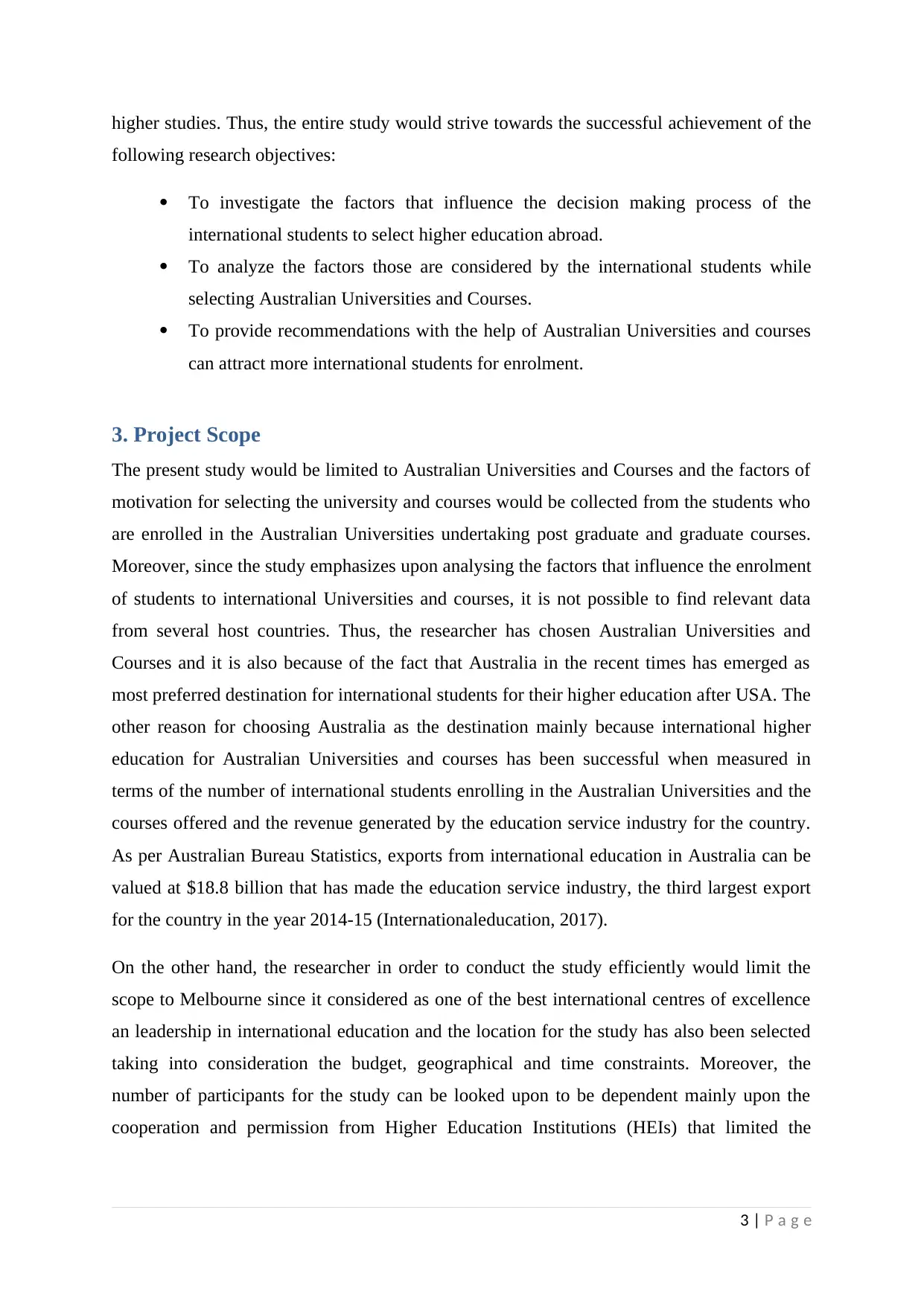
higher studies. Thus, the entire study would strive towards the successful achievement of the
following research objectives:
To investigate the factors that influence the decision making process of the
international students to select higher education abroad.
To analyze the factors those are considered by the international students while
selecting Australian Universities and Courses.
To provide recommendations with the help of Australian Universities and courses
can attract more international students for enrolment.
3. Project Scope
The present study would be limited to Australian Universities and Courses and the factors of
motivation for selecting the university and courses would be collected from the students who
are enrolled in the Australian Universities undertaking post graduate and graduate courses.
Moreover, since the study emphasizes upon analysing the factors that influence the enrolment
of students to international Universities and courses, it is not possible to find relevant data
from several host countries. Thus, the researcher has chosen Australian Universities and
Courses and it is also because of the fact that Australia in the recent times has emerged as
most preferred destination for international students for their higher education after USA. The
other reason for choosing Australia as the destination mainly because international higher
education for Australian Universities and courses has been successful when measured in
terms of the number of international students enrolling in the Australian Universities and the
courses offered and the revenue generated by the education service industry for the country.
As per Australian Bureau Statistics, exports from international education in Australia can be
valued at $18.8 billion that has made the education service industry, the third largest export
for the country in the year 2014-15 (Internationaleducation, 2017).
On the other hand, the researcher in order to conduct the study efficiently would limit the
scope to Melbourne since it considered as one of the best international centres of excellence
an leadership in international education and the location for the study has also been selected
taking into consideration the budget, geographical and time constraints. Moreover, the
number of participants for the study can be looked upon to be dependent mainly upon the
cooperation and permission from Higher Education Institutions (HEIs) that limited the
3 | P a g e
following research objectives:
To investigate the factors that influence the decision making process of the
international students to select higher education abroad.
To analyze the factors those are considered by the international students while
selecting Australian Universities and Courses.
To provide recommendations with the help of Australian Universities and courses
can attract more international students for enrolment.
3. Project Scope
The present study would be limited to Australian Universities and Courses and the factors of
motivation for selecting the university and courses would be collected from the students who
are enrolled in the Australian Universities undertaking post graduate and graduate courses.
Moreover, since the study emphasizes upon analysing the factors that influence the enrolment
of students to international Universities and courses, it is not possible to find relevant data
from several host countries. Thus, the researcher has chosen Australian Universities and
Courses and it is also because of the fact that Australia in the recent times has emerged as
most preferred destination for international students for their higher education after USA. The
other reason for choosing Australia as the destination mainly because international higher
education for Australian Universities and courses has been successful when measured in
terms of the number of international students enrolling in the Australian Universities and the
courses offered and the revenue generated by the education service industry for the country.
As per Australian Bureau Statistics, exports from international education in Australia can be
valued at $18.8 billion that has made the education service industry, the third largest export
for the country in the year 2014-15 (Internationaleducation, 2017).
On the other hand, the researcher in order to conduct the study efficiently would limit the
scope to Melbourne since it considered as one of the best international centres of excellence
an leadership in international education and the location for the study has also been selected
taking into consideration the budget, geographical and time constraints. Moreover, the
number of participants for the study can be looked upon to be dependent mainly upon the
cooperation and permission from Higher Education Institutions (HEIs) that limited the
3 | P a g e
Paraphrase This Document
Need a fresh take? Get an instant paraphrase of this document with our AI Paraphraser

sample size of the study. So, the study would be limited mainly to four HEIs in Victoria
(Melbourne).
4. Literature Review
The studies conducted by Gonzalez et al., (2011) has revealed that while introducing a new
product or service in the market, it is important for the producer to gain an enhanced
understanding of the specific needs of the customers. Enhanced understanding of the specific
needs proves to be beneficial in developing products and services capable of meeting the
identified needs. So, in this context, James et al., (2010) proposed the fact that to gain an
understanding of the specific needs of the international students while taking a decision to
study abroad, there are five group of factors and include the characteristics of the Higher
Education Institutions, characteristics of the host country, sources of information, the benefits
and risks associated with the selection of the course and the destination.
Bodycott, (2009) opined that there are various sources of information that the international
students refer to in order to seek valuable information while taking the decision to study
abroad and he also proposed that these sources of information not only facilitate the students
with relevant information, rather it also influences the decision making process of the
students for enrolling at HEIs in the destination country. The sources of information include
the friends, relatives, family members, private agents, Australian Education Centres (AECs)
and education exhibitions and other sources that include the magazines, internet (website of
HEIs) and newspapers.
In context to the second factor i.e. the characteristics of HEIs, Hasan et al., (2009) proposed
the fact that students while taking the decision of studying aboard and selecting the
destination tend to evaluate factors like the tution fees, the recognition of qualification,
reputation of HEIs, standard of the course and programme, range of programmes and courses
available, facilities provided by the HEI for international students, financial aid available for
the international students, time required for completion of the courses, exemption systems
and counselling services.
In context to the third factor, i.e. the country characteristics, it was proposed by Eder et al.,
(2010) that while selecting the destination country for studying abroad, the students strive
towards evaluating factors that include the cost of living, opportunity for migration,
4 | P a g e
(Melbourne).
4. Literature Review
The studies conducted by Gonzalez et al., (2011) has revealed that while introducing a new
product or service in the market, it is important for the producer to gain an enhanced
understanding of the specific needs of the customers. Enhanced understanding of the specific
needs proves to be beneficial in developing products and services capable of meeting the
identified needs. So, in this context, James et al., (2010) proposed the fact that to gain an
understanding of the specific needs of the international students while taking a decision to
study abroad, there are five group of factors and include the characteristics of the Higher
Education Institutions, characteristics of the host country, sources of information, the benefits
and risks associated with the selection of the course and the destination.
Bodycott, (2009) opined that there are various sources of information that the international
students refer to in order to seek valuable information while taking the decision to study
abroad and he also proposed that these sources of information not only facilitate the students
with relevant information, rather it also influences the decision making process of the
students for enrolling at HEIs in the destination country. The sources of information include
the friends, relatives, family members, private agents, Australian Education Centres (AECs)
and education exhibitions and other sources that include the magazines, internet (website of
HEIs) and newspapers.
In context to the second factor i.e. the characteristics of HEIs, Hasan et al., (2009) proposed
the fact that students while taking the decision of studying aboard and selecting the
destination tend to evaluate factors like the tution fees, the recognition of qualification,
reputation of HEIs, standard of the course and programme, range of programmes and courses
available, facilities provided by the HEI for international students, financial aid available for
the international students, time required for completion of the courses, exemption systems
and counselling services.
In context to the third factor, i.e. the country characteristics, it was proposed by Eder et al.,
(2010) that while selecting the destination country for studying abroad, the students strive
towards evaluating factors that include the cost of living, opportunity for migration,
4 | P a g e

opportunity for part time jobs, safety, geographical proximity, political stability, cultural
factors and issues and other facilities like public transportation available.
In context to the fourth factors i.e. benefit associated, Salisbury et al., (2009) opined that
consumers strive towards trading off against the price they tend to pay for the products and
services and then compare the results in the perception of value. Thus, if the value received is
high, the willingness on the part of the customers to adopt the new products and services is
more. Thus, in context to selecting Australia for higher studies, the students from the
Southeast Asian countries, Middle-east and Pacific Islands perceive that by studying in
Australia, the opportunities to have good carriers in their home countries would increase and
also would lead to enhanced experience. Other benefits that are perceived by the international
students include the language improvement, intercultural exchange.
In context to the fifth factor i.e. the risk associated, it was put forward by Salisbury et al.,
(2011) that perceived risk can be referred to as uncertainty on the part of the consumers due
to their inability to foresee the consequence of their decision to make the purchase. Thus in
case of the decision making process of the international student to study abroad in countries
like Australia, the student might face challenges in terms of cultural shock, homesickness,
problems in speaking and understanding English, financial constraint and racial
discrimination.
Thus from the above discussions, it can be said that there are various factors that tend to
make a significant influence on the decision making process of the students while selecting a
destination country and a university for studying abroad.
Problem Statement
The studies of Mpinganjira, (2009) has revealed that global mobility in higher education
services has emerged as a major factor by the developed countries like USA, UK and
Australia and other non-speaking countries like Japan, Malaysia and Singapore. English has
been recognised as a global language for communication across the globe and thus has
influenced the HEIs while offering international programmes. Moreover, in the recent times,
there has been an increase in the demand for studying abroad on the part of the international
students and so, it has become important for the HEIs of the countries to understand the
specific needs of the international students and the factors that encourage and influence their
decision of selecting the destination country and university for undertaking higher education
(Phang, 2013).
5 | P a g e
factors and issues and other facilities like public transportation available.
In context to the fourth factors i.e. benefit associated, Salisbury et al., (2009) opined that
consumers strive towards trading off against the price they tend to pay for the products and
services and then compare the results in the perception of value. Thus, if the value received is
high, the willingness on the part of the customers to adopt the new products and services is
more. Thus, in context to selecting Australia for higher studies, the students from the
Southeast Asian countries, Middle-east and Pacific Islands perceive that by studying in
Australia, the opportunities to have good carriers in their home countries would increase and
also would lead to enhanced experience. Other benefits that are perceived by the international
students include the language improvement, intercultural exchange.
In context to the fifth factor i.e. the risk associated, it was put forward by Salisbury et al.,
(2011) that perceived risk can be referred to as uncertainty on the part of the consumers due
to their inability to foresee the consequence of their decision to make the purchase. Thus in
case of the decision making process of the international student to study abroad in countries
like Australia, the student might face challenges in terms of cultural shock, homesickness,
problems in speaking and understanding English, financial constraint and racial
discrimination.
Thus from the above discussions, it can be said that there are various factors that tend to
make a significant influence on the decision making process of the students while selecting a
destination country and a university for studying abroad.
Problem Statement
The studies of Mpinganjira, (2009) has revealed that global mobility in higher education
services has emerged as a major factor by the developed countries like USA, UK and
Australia and other non-speaking countries like Japan, Malaysia and Singapore. English has
been recognised as a global language for communication across the globe and thus has
influenced the HEIs while offering international programmes. Moreover, in the recent times,
there has been an increase in the demand for studying abroad on the part of the international
students and so, it has become important for the HEIs of the countries to understand the
specific needs of the international students and the factors that encourage and influence their
decision of selecting the destination country and university for undertaking higher education
(Phang, 2013).
5 | P a g e
⊘ This is a preview!⊘
Do you want full access?
Subscribe today to unlock all pages.

Trusted by 1+ million students worldwide
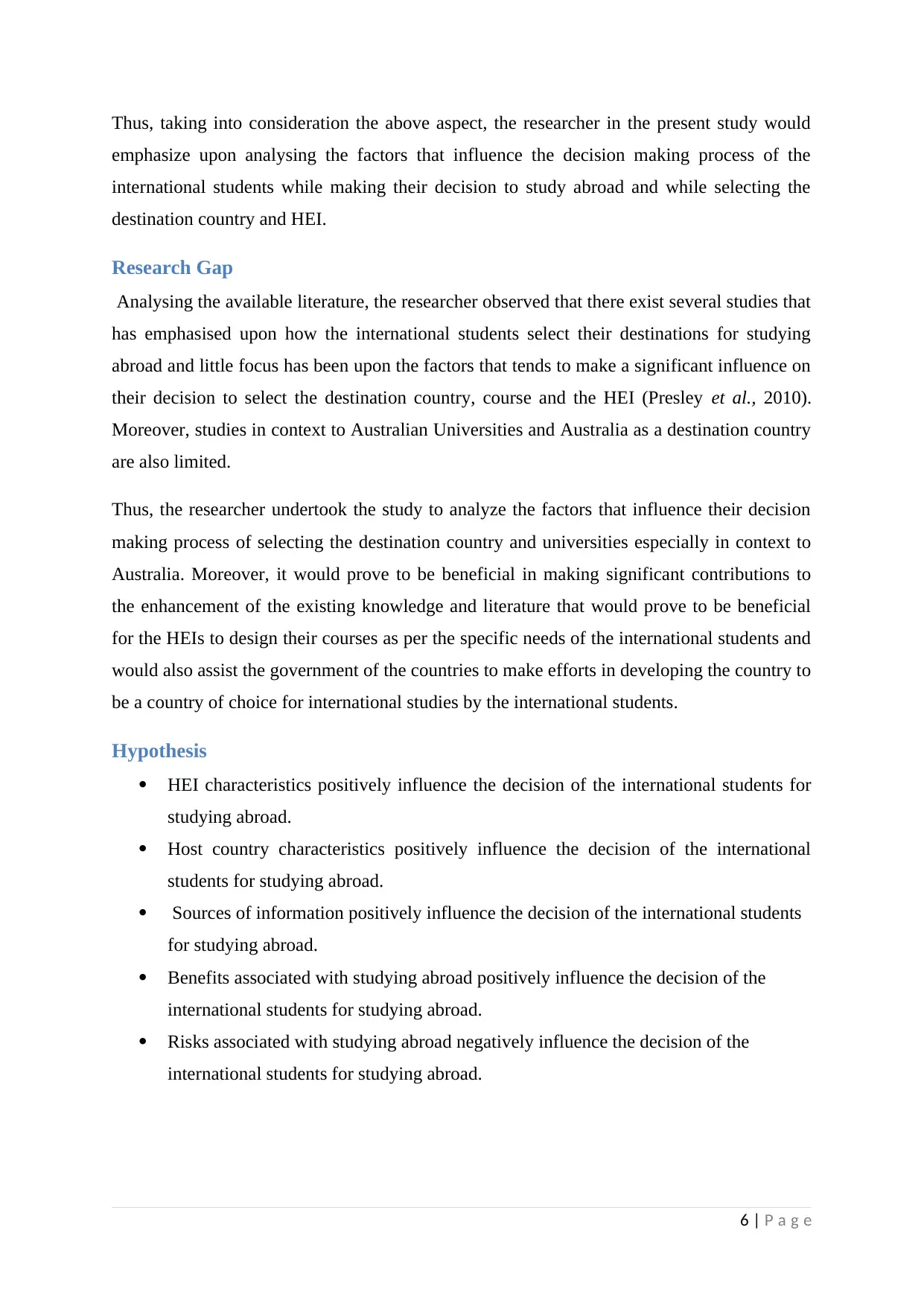
Thus, taking into consideration the above aspect, the researcher in the present study would
emphasize upon analysing the factors that influence the decision making process of the
international students while making their decision to study abroad and while selecting the
destination country and HEI.
Research Gap
Analysing the available literature, the researcher observed that there exist several studies that
has emphasised upon how the international students select their destinations for studying
abroad and little focus has been upon the factors that tends to make a significant influence on
their decision to select the destination country, course and the HEI (Presley et al., 2010).
Moreover, studies in context to Australian Universities and Australia as a destination country
are also limited.
Thus, the researcher undertook the study to analyze the factors that influence their decision
making process of selecting the destination country and universities especially in context to
Australia. Moreover, it would prove to be beneficial in making significant contributions to
the enhancement of the existing knowledge and literature that would prove to be beneficial
for the HEIs to design their courses as per the specific needs of the international students and
would also assist the government of the countries to make efforts in developing the country to
be a country of choice for international studies by the international students.
Hypothesis
HEI characteristics positively influence the decision of the international students for
studying abroad.
Host country characteristics positively influence the decision of the international
students for studying abroad.
Sources of information positively influence the decision of the international students
for studying abroad.
Benefits associated with studying abroad positively influence the decision of the
international students for studying abroad.
Risks associated with studying abroad negatively influence the decision of the
international students for studying abroad.
6 | P a g e
emphasize upon analysing the factors that influence the decision making process of the
international students while making their decision to study abroad and while selecting the
destination country and HEI.
Research Gap
Analysing the available literature, the researcher observed that there exist several studies that
has emphasised upon how the international students select their destinations for studying
abroad and little focus has been upon the factors that tends to make a significant influence on
their decision to select the destination country, course and the HEI (Presley et al., 2010).
Moreover, studies in context to Australian Universities and Australia as a destination country
are also limited.
Thus, the researcher undertook the study to analyze the factors that influence their decision
making process of selecting the destination country and universities especially in context to
Australia. Moreover, it would prove to be beneficial in making significant contributions to
the enhancement of the existing knowledge and literature that would prove to be beneficial
for the HEIs to design their courses as per the specific needs of the international students and
would also assist the government of the countries to make efforts in developing the country to
be a country of choice for international studies by the international students.
Hypothesis
HEI characteristics positively influence the decision of the international students for
studying abroad.
Host country characteristics positively influence the decision of the international
students for studying abroad.
Sources of information positively influence the decision of the international students
for studying abroad.
Benefits associated with studying abroad positively influence the decision of the
international students for studying abroad.
Risks associated with studying abroad negatively influence the decision of the
international students for studying abroad.
6 | P a g e
Paraphrase This Document
Need a fresh take? Get an instant paraphrase of this document with our AI Paraphraser
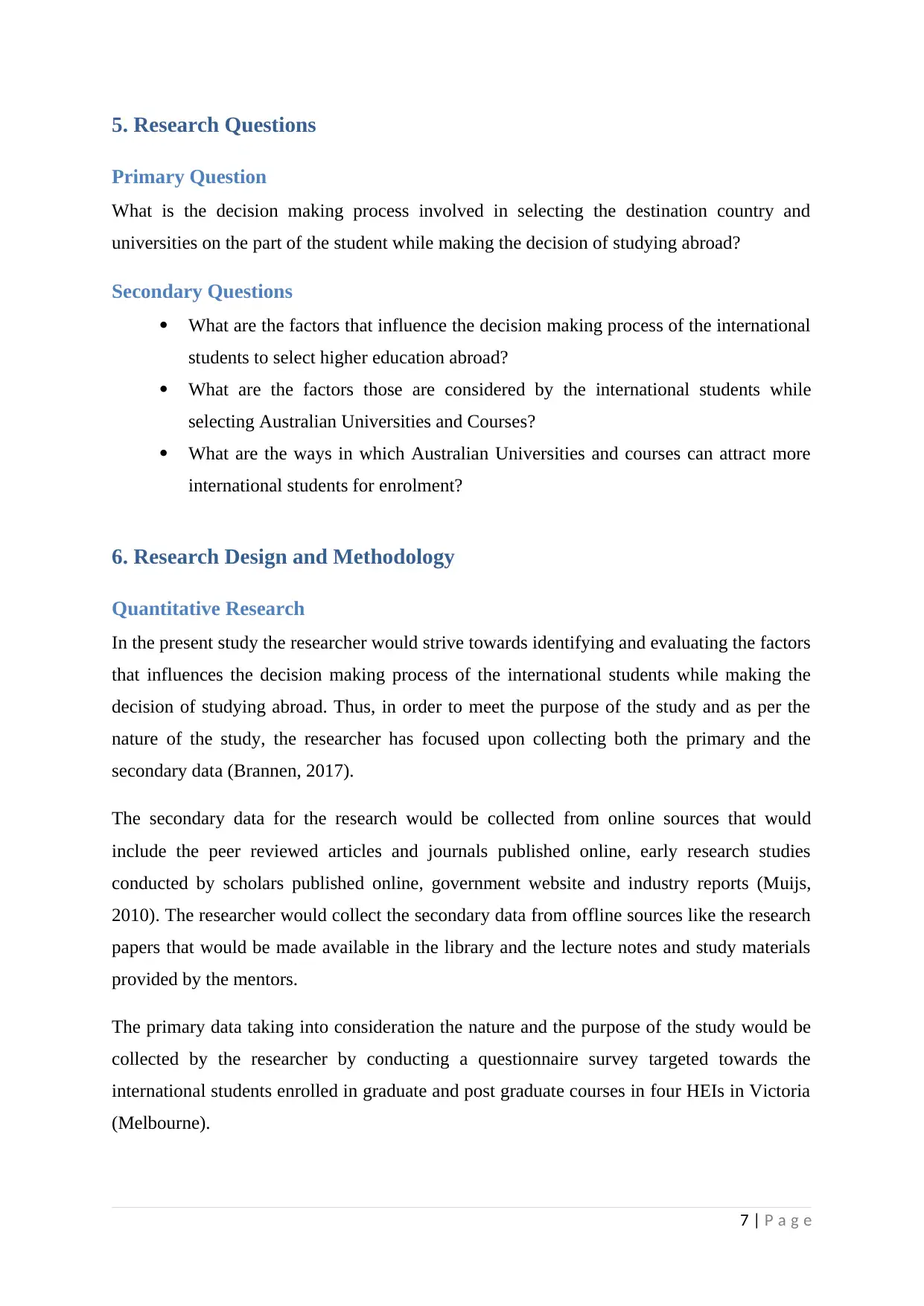
5. Research Questions
Primary Question
What is the decision making process involved in selecting the destination country and
universities on the part of the student while making the decision of studying abroad?
Secondary Questions
What are the factors that influence the decision making process of the international
students to select higher education abroad?
What are the factors those are considered by the international students while
selecting Australian Universities and Courses?
What are the ways in which Australian Universities and courses can attract more
international students for enrolment?
6. Research Design and Methodology
Quantitative Research
In the present study the researcher would strive towards identifying and evaluating the factors
that influences the decision making process of the international students while making the
decision of studying abroad. Thus, in order to meet the purpose of the study and as per the
nature of the study, the researcher has focused upon collecting both the primary and the
secondary data (Brannen, 2017).
The secondary data for the research would be collected from online sources that would
include the peer reviewed articles and journals published online, early research studies
conducted by scholars published online, government website and industry reports (Muijs,
2010). The researcher would collect the secondary data from offline sources like the research
papers that would be made available in the library and the lecture notes and study materials
provided by the mentors.
The primary data taking into consideration the nature and the purpose of the study would be
collected by the researcher by conducting a questionnaire survey targeted towards the
international students enrolled in graduate and post graduate courses in four HEIs in Victoria
(Melbourne).
7 | P a g e
Primary Question
What is the decision making process involved in selecting the destination country and
universities on the part of the student while making the decision of studying abroad?
Secondary Questions
What are the factors that influence the decision making process of the international
students to select higher education abroad?
What are the factors those are considered by the international students while
selecting Australian Universities and Courses?
What are the ways in which Australian Universities and courses can attract more
international students for enrolment?
6. Research Design and Methodology
Quantitative Research
In the present study the researcher would strive towards identifying and evaluating the factors
that influences the decision making process of the international students while making the
decision of studying abroad. Thus, in order to meet the purpose of the study and as per the
nature of the study, the researcher has focused upon collecting both the primary and the
secondary data (Brannen, 2017).
The secondary data for the research would be collected from online sources that would
include the peer reviewed articles and journals published online, early research studies
conducted by scholars published online, government website and industry reports (Muijs,
2010). The researcher would collect the secondary data from offline sources like the research
papers that would be made available in the library and the lecture notes and study materials
provided by the mentors.
The primary data taking into consideration the nature and the purpose of the study would be
collected by the researcher by conducting a questionnaire survey targeted towards the
international students enrolled in graduate and post graduate courses in four HEIs in Victoria
(Melbourne).
7 | P a g e
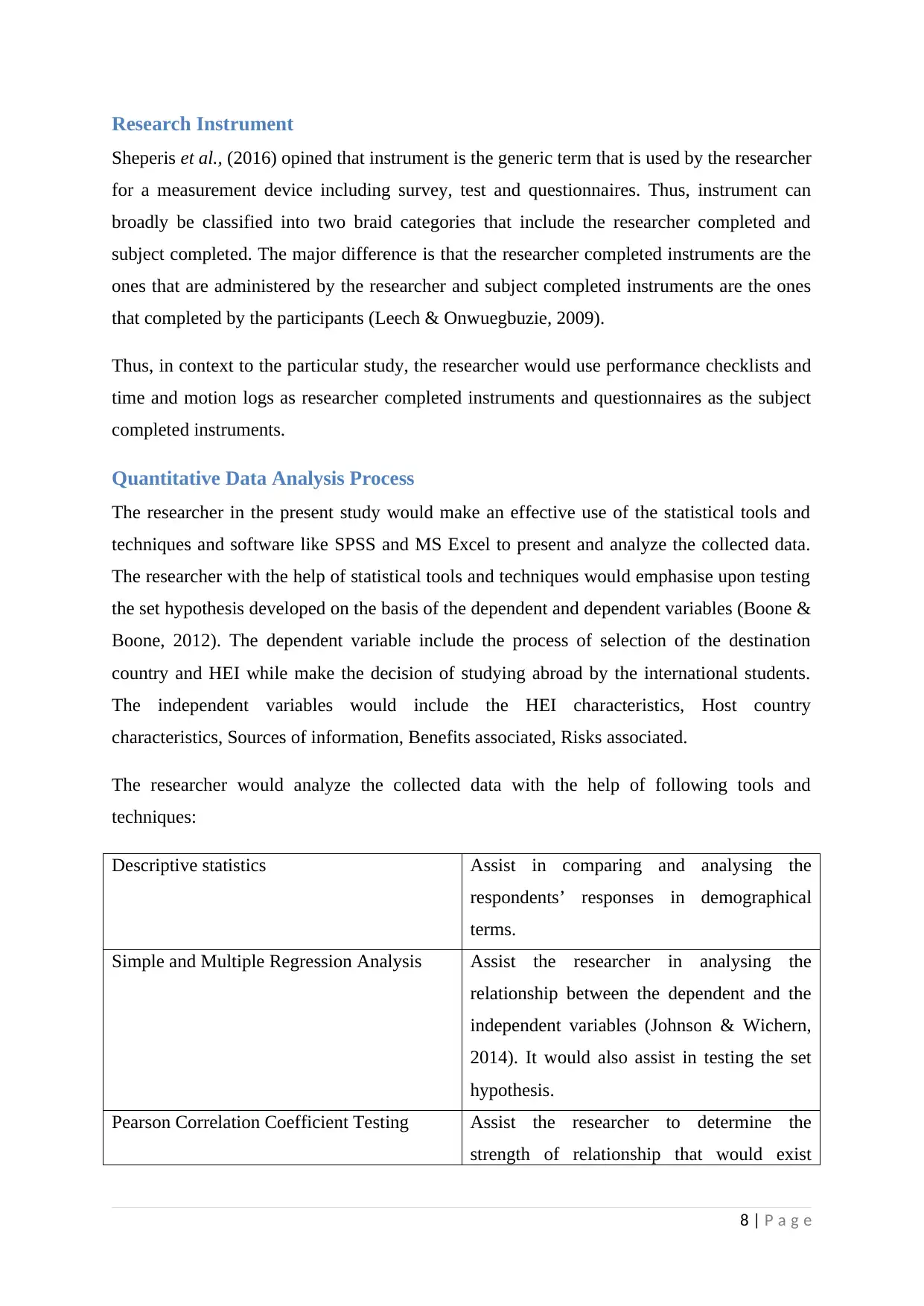
Research Instrument
Sheperis et al., (2016) opined that instrument is the generic term that is used by the researcher
for a measurement device including survey, test and questionnaires. Thus, instrument can
broadly be classified into two braid categories that include the researcher completed and
subject completed. The major difference is that the researcher completed instruments are the
ones that are administered by the researcher and subject completed instruments are the ones
that completed by the participants (Leech & Onwuegbuzie, 2009).
Thus, in context to the particular study, the researcher would use performance checklists and
time and motion logs as researcher completed instruments and questionnaires as the subject
completed instruments.
Quantitative Data Analysis Process
The researcher in the present study would make an effective use of the statistical tools and
techniques and software like SPSS and MS Excel to present and analyze the collected data.
The researcher with the help of statistical tools and techniques would emphasise upon testing
the set hypothesis developed on the basis of the dependent and dependent variables (Boone &
Boone, 2012). The dependent variable include the process of selection of the destination
country and HEI while make the decision of studying abroad by the international students.
The independent variables would include the HEI characteristics, Host country
characteristics, Sources of information, Benefits associated, Risks associated.
The researcher would analyze the collected data with the help of following tools and
techniques:
Descriptive statistics Assist in comparing and analysing the
respondents’ responses in demographical
terms.
Simple and Multiple Regression Analysis Assist the researcher in analysing the
relationship between the dependent and the
independent variables (Johnson & Wichern,
2014). It would also assist in testing the set
hypothesis.
Pearson Correlation Coefficient Testing Assist the researcher to determine the
strength of relationship that would exist
8 | P a g e
Sheperis et al., (2016) opined that instrument is the generic term that is used by the researcher
for a measurement device including survey, test and questionnaires. Thus, instrument can
broadly be classified into two braid categories that include the researcher completed and
subject completed. The major difference is that the researcher completed instruments are the
ones that are administered by the researcher and subject completed instruments are the ones
that completed by the participants (Leech & Onwuegbuzie, 2009).
Thus, in context to the particular study, the researcher would use performance checklists and
time and motion logs as researcher completed instruments and questionnaires as the subject
completed instruments.
Quantitative Data Analysis Process
The researcher in the present study would make an effective use of the statistical tools and
techniques and software like SPSS and MS Excel to present and analyze the collected data.
The researcher with the help of statistical tools and techniques would emphasise upon testing
the set hypothesis developed on the basis of the dependent and dependent variables (Boone &
Boone, 2012). The dependent variable include the process of selection of the destination
country and HEI while make the decision of studying abroad by the international students.
The independent variables would include the HEI characteristics, Host country
characteristics, Sources of information, Benefits associated, Risks associated.
The researcher would analyze the collected data with the help of following tools and
techniques:
Descriptive statistics Assist in comparing and analysing the
respondents’ responses in demographical
terms.
Simple and Multiple Regression Analysis Assist the researcher in analysing the
relationship between the dependent and the
independent variables (Johnson & Wichern,
2014). It would also assist in testing the set
hypothesis.
Pearson Correlation Coefficient Testing Assist the researcher to determine the
strength of relationship that would exist
8 | P a g e
⊘ This is a preview!⊘
Do you want full access?
Subscribe today to unlock all pages.

Trusted by 1+ million students worldwide
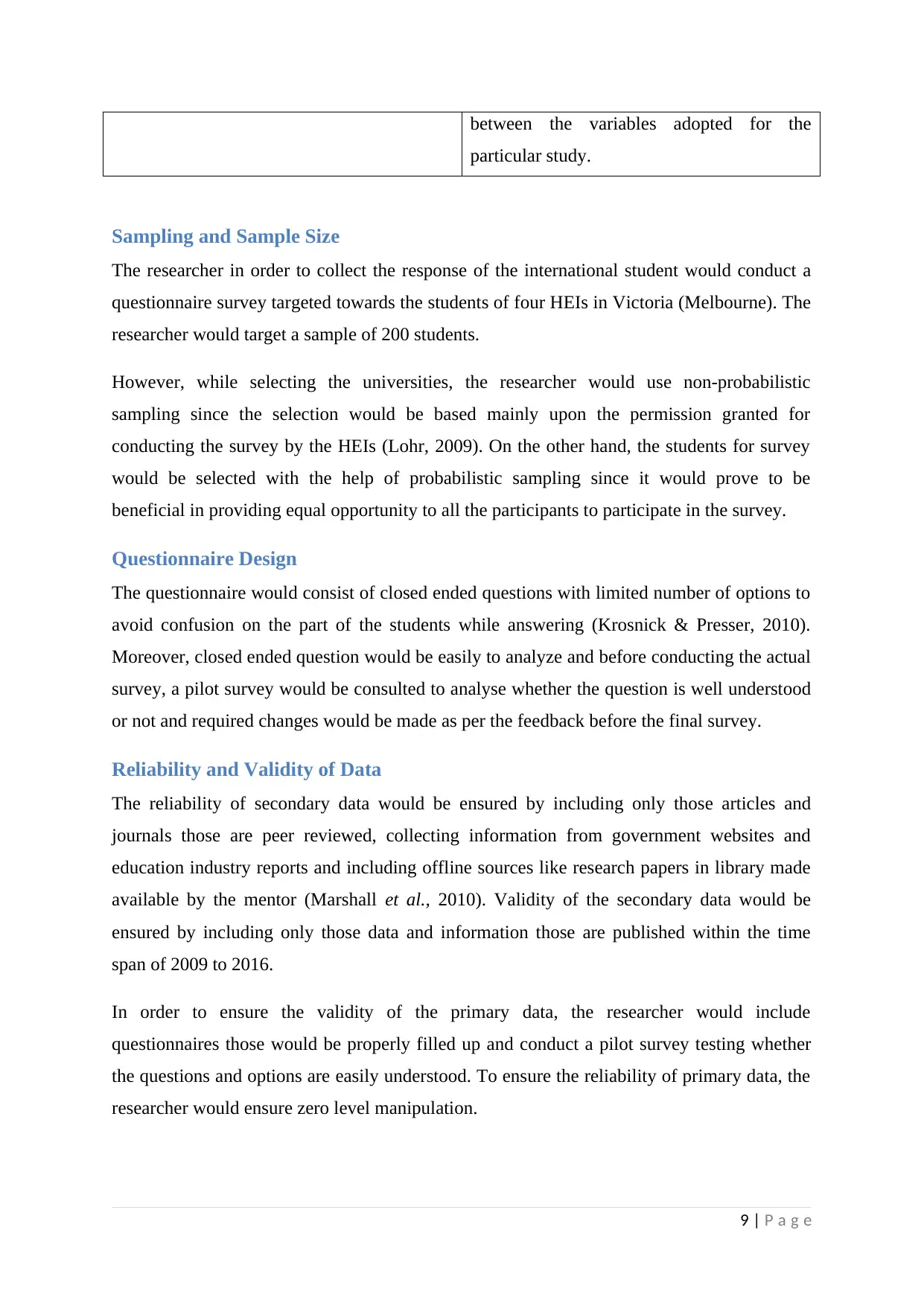
between the variables adopted for the
particular study.
Sampling and Sample Size
The researcher in order to collect the response of the international student would conduct a
questionnaire survey targeted towards the students of four HEIs in Victoria (Melbourne). The
researcher would target a sample of 200 students.
However, while selecting the universities, the researcher would use non-probabilistic
sampling since the selection would be based mainly upon the permission granted for
conducting the survey by the HEIs (Lohr, 2009). On the other hand, the students for survey
would be selected with the help of probabilistic sampling since it would prove to be
beneficial in providing equal opportunity to all the participants to participate in the survey.
Questionnaire Design
The questionnaire would consist of closed ended questions with limited number of options to
avoid confusion on the part of the students while answering (Krosnick & Presser, 2010).
Moreover, closed ended question would be easily to analyze and before conducting the actual
survey, a pilot survey would be consulted to analyse whether the question is well understood
or not and required changes would be made as per the feedback before the final survey.
Reliability and Validity of Data
The reliability of secondary data would be ensured by including only those articles and
journals those are peer reviewed, collecting information from government websites and
education industry reports and including offline sources like research papers in library made
available by the mentor (Marshall et al., 2010). Validity of the secondary data would be
ensured by including only those data and information those are published within the time
span of 2009 to 2016.
In order to ensure the validity of the primary data, the researcher would include
questionnaires those would be properly filled up and conduct a pilot survey testing whether
the questions and options are easily understood. To ensure the reliability of primary data, the
researcher would ensure zero level manipulation.
9 | P a g e
particular study.
Sampling and Sample Size
The researcher in order to collect the response of the international student would conduct a
questionnaire survey targeted towards the students of four HEIs in Victoria (Melbourne). The
researcher would target a sample of 200 students.
However, while selecting the universities, the researcher would use non-probabilistic
sampling since the selection would be based mainly upon the permission granted for
conducting the survey by the HEIs (Lohr, 2009). On the other hand, the students for survey
would be selected with the help of probabilistic sampling since it would prove to be
beneficial in providing equal opportunity to all the participants to participate in the survey.
Questionnaire Design
The questionnaire would consist of closed ended questions with limited number of options to
avoid confusion on the part of the students while answering (Krosnick & Presser, 2010).
Moreover, closed ended question would be easily to analyze and before conducting the actual
survey, a pilot survey would be consulted to analyse whether the question is well understood
or not and required changes would be made as per the feedback before the final survey.
Reliability and Validity of Data
The reliability of secondary data would be ensured by including only those articles and
journals those are peer reviewed, collecting information from government websites and
education industry reports and including offline sources like research papers in library made
available by the mentor (Marshall et al., 2010). Validity of the secondary data would be
ensured by including only those data and information those are published within the time
span of 2009 to 2016.
In order to ensure the validity of the primary data, the researcher would include
questionnaires those would be properly filled up and conduct a pilot survey testing whether
the questions and options are easily understood. To ensure the reliability of primary data, the
researcher would ensure zero level manipulation.
9 | P a g e
Paraphrase This Document
Need a fresh take? Get an instant paraphrase of this document with our AI Paraphraser
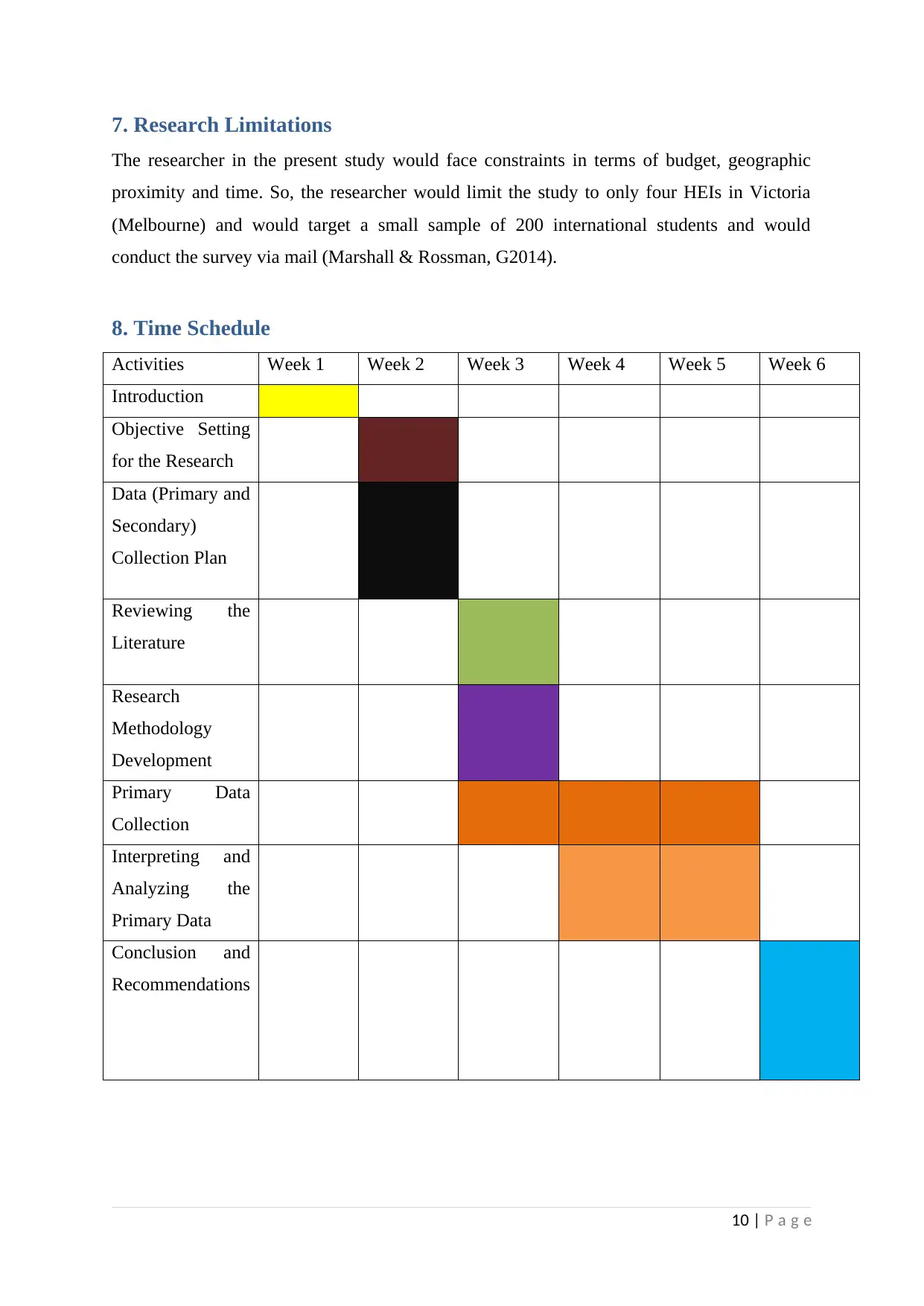
7. Research Limitations
The researcher in the present study would face constraints in terms of budget, geographic
proximity and time. So, the researcher would limit the study to only four HEIs in Victoria
(Melbourne) and would target a small sample of 200 international students and would
conduct the survey via mail (Marshall & Rossman, G2014).
8. Time Schedule
Activities Week 1 Week 2 Week 3 Week 4 Week 5 Week 6
Introduction
Objective Setting
for the Research
Data (Primary and
Secondary)
Collection Plan
Reviewing the
Literature
Research
Methodology
Development
Primary Data
Collection
Interpreting and
Analyzing the
Primary Data
Conclusion and
Recommendations
10 | P a g e
The researcher in the present study would face constraints in terms of budget, geographic
proximity and time. So, the researcher would limit the study to only four HEIs in Victoria
(Melbourne) and would target a small sample of 200 international students and would
conduct the survey via mail (Marshall & Rossman, G2014).
8. Time Schedule
Activities Week 1 Week 2 Week 3 Week 4 Week 5 Week 6
Introduction
Objective Setting
for the Research
Data (Primary and
Secondary)
Collection Plan
Reviewing the
Literature
Research
Methodology
Development
Primary Data
Collection
Interpreting and
Analyzing the
Primary Data
Conclusion and
Recommendations
10 | P a g e
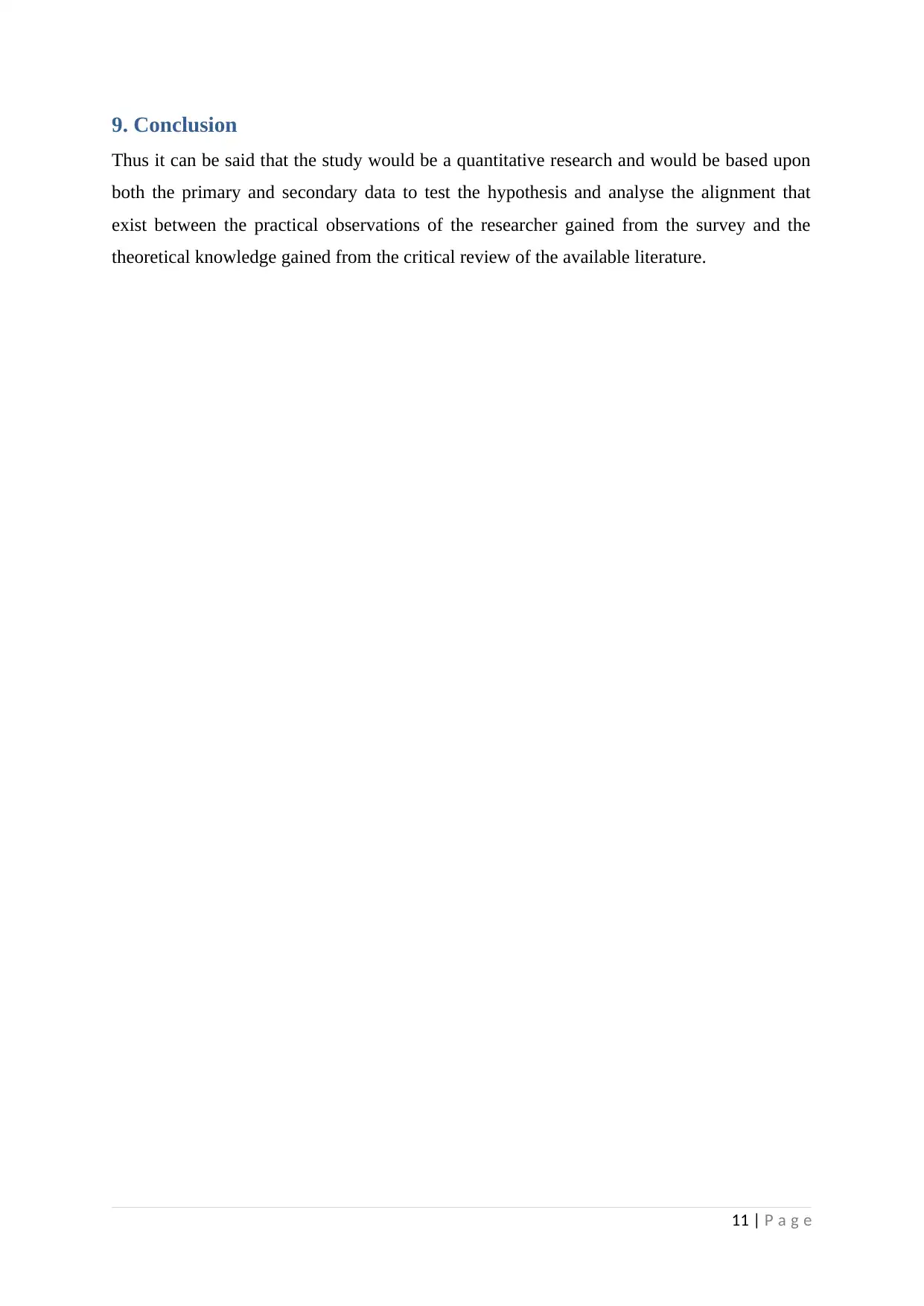
9. Conclusion
Thus it can be said that the study would be a quantitative research and would be based upon
both the primary and secondary data to test the hypothesis and analyse the alignment that
exist between the practical observations of the researcher gained from the survey and the
theoretical knowledge gained from the critical review of the available literature.
11 | P a g e
Thus it can be said that the study would be a quantitative research and would be based upon
both the primary and secondary data to test the hypothesis and analyse the alignment that
exist between the practical observations of the researcher gained from the survey and the
theoretical knowledge gained from the critical review of the available literature.
11 | P a g e
⊘ This is a preview!⊘
Do you want full access?
Subscribe today to unlock all pages.

Trusted by 1+ million students worldwide
1 out of 15
Related Documents
Your All-in-One AI-Powered Toolkit for Academic Success.
+13062052269
info@desklib.com
Available 24*7 on WhatsApp / Email
![[object Object]](/_next/static/media/star-bottom.7253800d.svg)
Unlock your academic potential
Copyright © 2020–2025 A2Z Services. All Rights Reserved. Developed and managed by ZUCOL.





